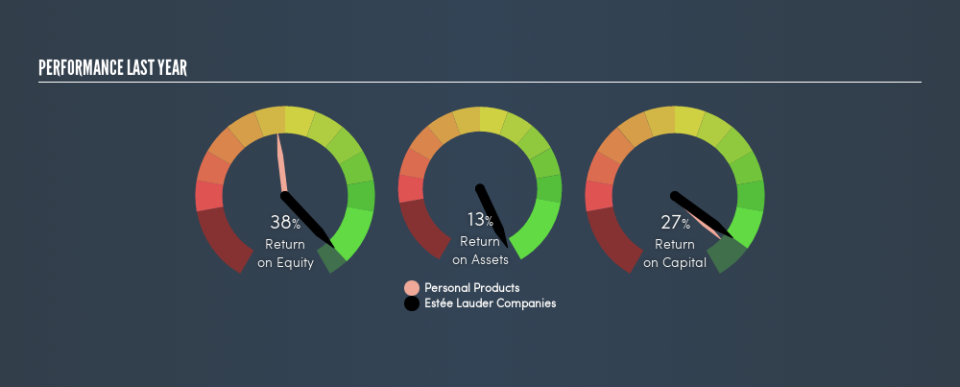Is The Estée Lauder Companies Inc. (NYSE:EL) Investing Effectively In Its Business?

Today we’ll evaluate The Estée Lauder Companies Inc. (NYSE:EL) to determine whether it could have potential as an investment idea. To be precise, we’ll consider its Return On Capital Employed (ROCE), as that will inform our view of the quality of the business.
Firstly, we’ll go over how we calculate ROCE. Second, we’ll look at its ROCE compared to similar companies. Then we’ll determine how its current liabilities are affecting its ROCE.
Understanding Return On Capital Employed (ROCE)
ROCE measures the ‘return’ (pre-tax profit) a company generates from capital employed in its business. Generally speaking a higher ROCE is better. Ultimately, it is a useful but imperfect metric. Renowned investment researcher Michael Mauboussin has suggested that a high ROCE can indicate that ‘one dollar invested in the company generates value of more than one dollar’.
How Do You Calculate Return On Capital Employed?
The formula for calculating the return on capital employed is:
Return on Capital Employed = Earnings Before Interest and Tax (EBIT) ÷ (Total Assets – Current Liabilities)
Or for Estée Lauder Companies:
0.27 = US$2.4b ÷ (US$13b – US$3.8b) (Based on the trailing twelve months to December 2018.)
So, Estée Lauder Companies has an ROCE of 27%.
Check out our latest analysis for Estée Lauder Companies
Is Estée Lauder Companies’s ROCE Good?
ROCE can be useful when making comparisons, such as between similar companies. It appears that Estée Lauder Companies’s ROCE is fairly close to the Personal Products industry average of 24%. Putting aside its position relative to its industry for now, in absolute terms, Estée Lauder Companies’s ROCE is currently very good.
Remember that this metric is backwards looking – it shows what has happened in the past, and does not accurately predict the future. Companies in cyclical industries can be difficult to understand using ROCE, as returns typically look high during boom times, and low during busts. ROCE is, after all, simply a snap shot of a single year. Since the future is so important for investors, you should check out our free report on analyst forecasts for Estée Lauder Companies.
Estée Lauder Companies’s Current Liabilities And Their Impact On Its ROCE
Current liabilities include invoices, such as supplier payments, short-term debt, or a tax bill, that need to be paid within 12 months. Due to the way ROCE is calculated, a high level of current liabilities makes a company look as though it has less capital employed, and thus can (sometimes unfairly) boost the ROCE. To check the impact of this, we calculate if a company has high current liabilities relative to its total assets.
Estée Lauder Companies has total liabilities of US$3.8b and total assets of US$13b. As a result, its current liabilities are equal to approximately 30% of its total assets. A minimal amount of current liabilities limits the impact on ROCE.
The Bottom Line On Estée Lauder Companies’s ROCE
With low current liabilities and a high ROCE, Estée Lauder Companies could be worthy of further investigation. Of course you might be able to find a better stock than Estée Lauder Companies. So you may wish to see this free collection of other companies that have grown earnings strongly.
If you are like me, then you will not want to miss this free list of growing companies that insiders are buying.
We aim to bring you long-term focused research analysis driven by fundamental data. Note that our analysis may not factor in the latest price-sensitive company announcements or qualitative material.
If you spot an error that warrants correction, please contact the editor at editorial-team@simplywallst.com. This article by Simply Wall St is general in nature. It does not constitute a recommendation to buy or sell any stock, and does not take account of your objectives, or your financial situation. Simply Wall St has no position in the stocks mentioned. Thank you for reading.

